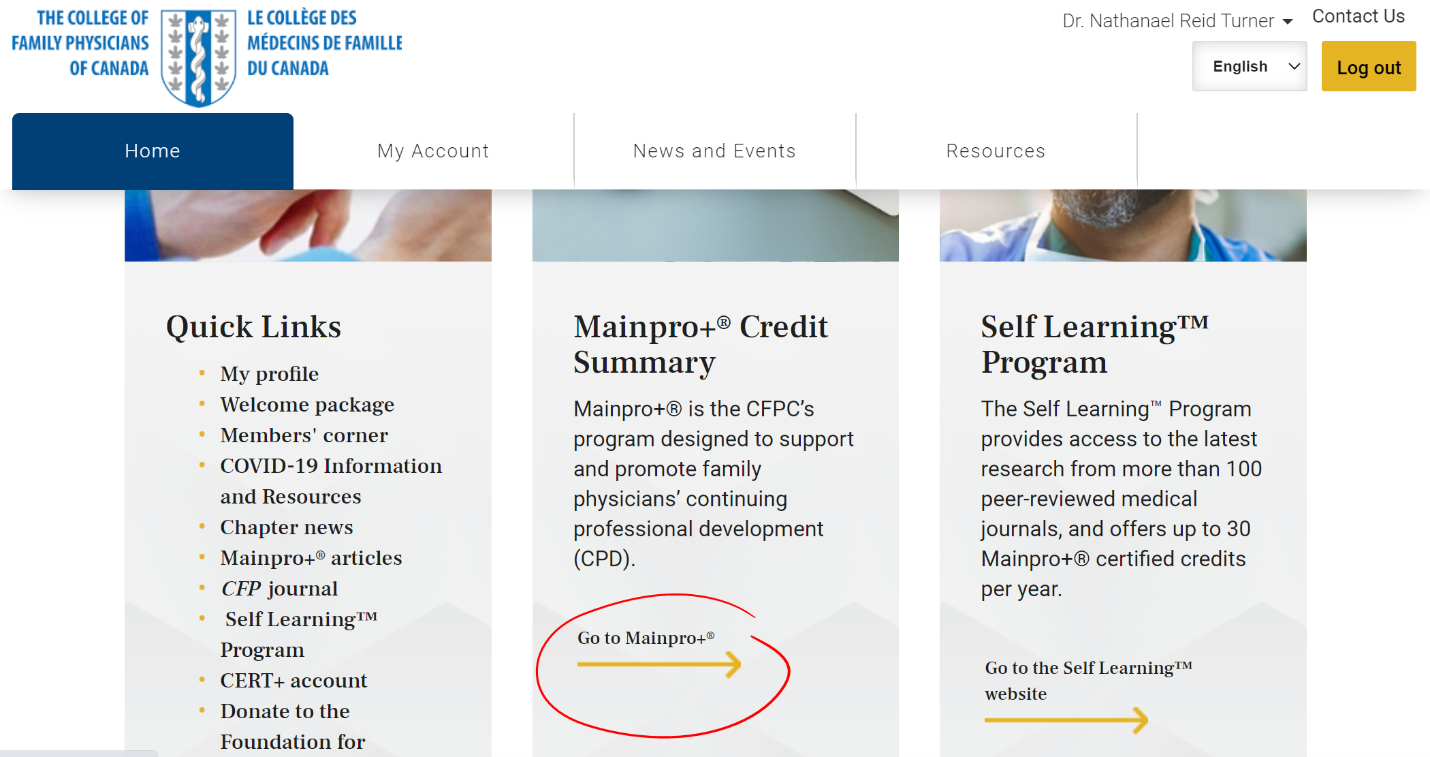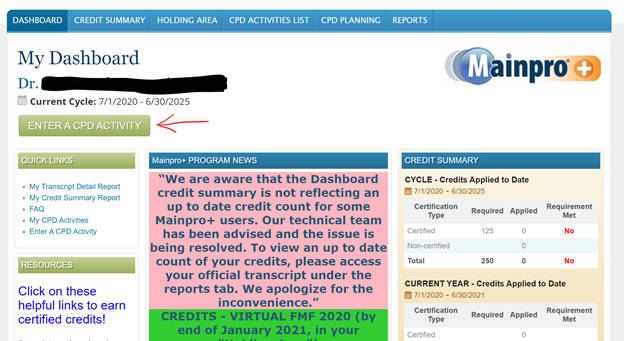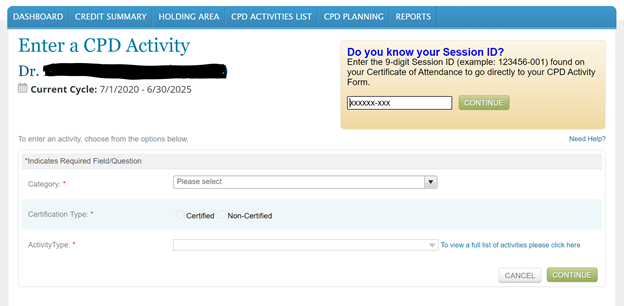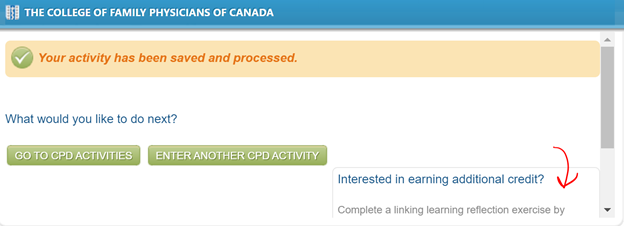By Nathan Turner MD, CCFP
As a new in practice family doctor there are many things that, while important for your practice and career, you may not have had much exposure to in residency. One of these is the Mainpro+ Continuing Professional Development (CPD) tracking system used by the College of Family Physicians of Canada (CFPC). As I explored this system in more detail these first few months in practice, I thought it might be beneficial for the soon-to-be-graduating residents, my colleagues who have recently started practice, and perhaps even some more seasoned family doctors to have a convenient review of the system and some general CPD tips and tricks. Feel free to browse through the whole post, or jump to sections of interest using the links below:
- What is Mainpro+ and how do I access it?
- What are the CFPC requirements for CPD?
- How do I track my CPD activities?
- CPD tips and tricks
- Resources
- Conclusion
***Disclaimer: while every effort has been made for accuracy in this article, official CFPC Mainpro+ resources are the final word, and may change from time to time. You can find links to them in the “Resources” section***
What is Mainpro+ and how do I access it?
Provincial regulatory colleges require CPD from doctors of all specialties to ensure we are staying up to date on the developments in our fields and continually improving our ability to care for patients. For family physicians, our national college uses Mainpro+ as the method to track and certify our CPD activities so that we can show we meet the regulatory standard.
Mainpro+ is accessible through the CFPC member portal. After you log in to the member portal (button in the top right of cfpc.ca), you can scroll down and click “Go to Mainpro+” in the middle pane:

This will bring you to your personal dashboard. Here you can find your cycle dates (see “requirements” section for more details), certified and non-certified credits reported in the current cycle and year, and you can access and print a summary or transcript. There is also the “enter CPD activity” button in the top left which I’ll talk about more in the “tracking” section.

What are the CFPC Requirements for CPD?
Mainpro+ certification works in 5-year cycles. Your first five years in practice will align with your first 5-year cycle. Over the 5 years you need a total of 250 credits (at least 125 of which must be Mainpro+ certified). You also need to get a yearly minimum of 25 credits/year. Cycles begin July 1st and end June 30th.
Certified credits come from activities that have been formally reviewed and approved by the CFPC to ensure they meet ethical, relevance, and quality standards. Events will generally advertise if they are certified activities. Many non-certified credits are based on the honour system in reporting hours spent in given activities. The following graphic outlines the different types of CPD activities you may encounter and gives some examples of each:

If you are away from practice for over 6 months (ex. parental leave, personal illness, etc.) you can contact the CFPC to discuss a possible extension of your CPD cycle. If you obtain more credits during a cycle than your requirement, you can carry over up to 40 credits into the next cycle. If you fail to meet the requirements for your cycle you will enter a two-year remedial cycle during which you will be unable to use CFPC designations and the remediation will be reported to the provincial regulatory authority (CPSA in Alberta). For further information on remediation see the links in the “resources” section.
How do I track my CPD activities?
It is best to enter your CPD activities into Mainpro+ shortly after receiving your certificate of attendance so as not to forget and to get the most use out of the opportunities for reflection and learning consolidation that the tracking provides.
Some events (like FMF) will add credits to your Mainpro+ account directly – these will go to your holding area where you will need to fill out an impact assessment to complete the process.
For most events you will need to enter the credits directly, so brief instructions are outlined below (for more information see the instructional video provided by Mainpro+).
Press the green “Enter a CPD Activity” button on the Mainpro+ dashboard (see above for a screenshot)
- If you know the session ID number, enter it in the yellow box, otherwise:
- Choose a category (group learning, self learning, or assessment – see above for examples of each activity)
- Select if it is certified or non-certified

- The activity list will populate based on the previous selections. Pick the corresponding activity from the list. Use advanced search to find the specific certified activity (all certified activities are registered with Mainpro+ and will have their own identification number)
- Fill out the impact assessment questionnaire or other information as required. For longer forms you can save and complete later, if necessary, using “Send to Holding Area”

- Upload any required documents (certificate of completion/attendance, etc.)
- Click the “Submit” button
- Linking learning credits (more info in “tips and tricks” section) are available through the submission confirmation window:

Certificates of completion need to be kept for a minimum of 6 years in case you are selected for a random audit. These can also be uploaded as part of your credit submission.
CPD tips and tricks
Transferring credits from residency
- Residents are encouraged to track extra-curricular CPD in Mainrpo+ and can carry forward up to 40 certified credits earned and reported in residency to be applied to their first-year cycle after graduation.
Keeping track of your CPD
- Some people find it helpful to track potential CPD activities that you participate in on a spreadsheet with the date, activity, time spent, and whether you’ve logged it in Mainpro+ or not yet. This is helpful because certificates of attendance are often delayed for some time after the event. It can also be quite useful when it comes time to update a CV or academic year report.
Credits from other organizations
- For American conferences or other CPD activities, American Association of Family Physicians (AAFP) prescribed credits are equivalent to certified credits and AAFP elective credits are equivalent to non-certified.
- Royal College of Physicians and Surgeons of Canada (RCPSC) Maintenance of Certification (MOC) credits are available for non-certified credits, or up to a maximum of 50 certified credits/cycle from Section 1 and 3 activities.
Note: industry sponsored events (ex. events by pharmaceutical companies) are ONLY eligible for credits if they have been certified by the CFPC (they cannot be used for non-certified credits).
For further details on this subject and for other available partner organizations see official CFPC info in the “Resources” section below.
How to decide on which CPD activities to participate in
There are many certified and non-certified CPD opportunities, and it can sometimes be overwhelming to know which ones are most worth the time, cost, and effort. The following are some important aspects to consider:
- Patient needs – is there a specific need in your patient population? Do you have many elderly patients or frequently find yourself managing prenatal care? Basing your CPD selections on the needs of patients in your practice is a great contribution to patient centered care.
- Clinical deficits/weaknesses – is there an aspect of your work that you routinely struggle with? Have you been finding chronic pain patients overwhelming, or haven’t dealt with concussion management since medical school? Perhaps your clinic could benefit from better team dynamics? Choosing CPD to buffer your weak areas can help you feel more comfortable in your day-to-day practice.
- Special interest, focus, or strengths – is there a certain area of your practice that you love? Are you hoping to become more proficient in procedural skills, or looking to do more patient counselling? Staying up to date on your area of expertise can help you to be a leader in the field and help colleagues in the future.
- Location, time, or networking opportunities – are you finding your only time for CPD is over your lunch break where you could benefit from online activities? Maybe you feel the need to get away to the mountains for a bit, or catch up with former colleagues? Where, when, and who is involved in CPD can all be important factors in your decision.
- Cost – many of us have felt the impact of the recent discontinuation of CPD funding through the Alberta Medical Association (AMA), or are struggling with decreased income from COVID or billing changes. Cost can also be an important factor in which CPD activities we are able to participate in.
These are just a few of many considerations. A relatively new feature on the Mainpro+ platform that can help is the “CPD Planning” section, where you can create a personal learning plan by outlining goals you have for your professional development and plan CPD activities that contribute to them:

Highlighted CPD Offerings
The following are some CPD opportunities that are favourites of the First Five Years in Family Practice Committee and why we like them:
- Self Study – Don’t forget to log your time in self study and looking up information for your patients for non-certified credits. Up To Date, journal articles, Tools for Practice, medical podcasts etc. can all count!
- Collaborative Mentorship Network – peer support for managing chronic pain and addiction. FREE mentorship program and regular, certified, online educational events.
- GoMainpro – online repository of on-demand learning resources, started in Alberta and recently adopted by the CFPC.
- Family Medicine Summit – yearly flagship conference hosted by the ACFP. Usually in Banff, currently online!
- Family Medicine Forum – the foremost Canada-wide annual family medicine conference hosted by the CFPC.
- Practical Evidence for Informed Practice (PEIP) – homegrown evidence-based family medicine in an engaging format, delivering pearls that are immediately applicable to practice.
- Linking Learning – FREE additional certified credits to expand on your other activities. These are reflective exercises for administration, assessment, practice, research, and teaching activities that give 5 certified credits for each exercise.
- Committee, teaching, and quality improvement work – don’t forget that many of the activities you already participate in can be used for non-certified credits, with additional certified credits able to be added through linking learning!
- Practice Based Small Group Learning Program – many family doctors enjoy getting together with colleagues to go over these cases as a great mix of CPD and staying in touch. It’s also certified, and credits can be automatically uploaded.
- Courses – Specific courses such as ACLS, LEAP, or ALARM which you may require anyway for hospital privileging can all provide credits, and most often they are certified
Resources
Conclusion
I hope that you found this summary helpful as an introduction or a reminder of how to approach CPD and the Mainpro+ system. If you have any of your own CPD tips and tricks please post them in the comments below! And don’t forget, to check the ACFP eNews for the “Mainpro+ Minute“, where you can answer a question for a chance to win prizes!


